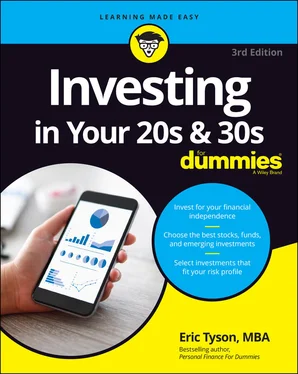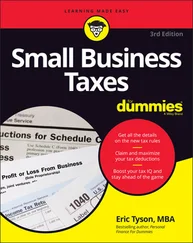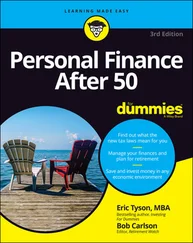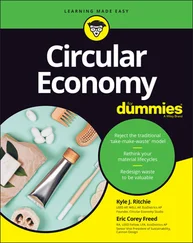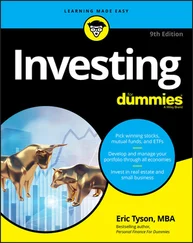Eric Tyson - Investing in Your 20s & 30s For Dummies
Здесь есть возможность читать онлайн «Eric Tyson - Investing in Your 20s & 30s For Dummies» — ознакомительный отрывок электронной книги совершенно бесплатно, а после прочтения отрывка купить полную версию. В некоторых случаях можно слушать аудио, скачать через торрент в формате fb2 и присутствует краткое содержание. Жанр: unrecognised, на английском языке. Описание произведения, (предисловие) а так же отзывы посетителей доступны на портале библиотеки ЛибКат.
- Название:Investing in Your 20s & 30s For Dummies
- Автор:
- Жанр:
- Год:неизвестен
- ISBN:нет данных
- Рейтинг книги:4 / 5. Голосов: 1
-
Избранное:Добавить в избранное
- Отзывы:
-
Ваша оценка:
- 80
- 1
- 2
- 3
- 4
- 5
Investing in Your 20s & 30s For Dummies: краткое содержание, описание и аннотация
Предлагаем к чтению аннотацию, описание, краткое содержание или предисловие (зависит от того, что написал сам автор книги «Investing in Your 20s & 30s For Dummies»). Если вы не нашли необходимую информацию о книге — напишите в комментариях, мы постараемся отыскать её.
Discover your unique investing style!
Inside. . .
Learn how to start investingChoose stocks and funds wiselyMinimize your tax billDecide how much to investGet into real estateManage your level of riskInvest in small businessDiversify your portfolio
Investing in Your 20s & 30s For Dummies — читать онлайн ознакомительный отрывок
Ниже представлен текст книги, разбитый по страницам. Система сохранения места последней прочитанной страницы, позволяет с удобством читать онлайн бесплатно книгу «Investing in Your 20s & 30s For Dummies», без необходимости каждый раз заново искать на чём Вы остановились. Поставьте закладку, и сможете в любой момент перейти на страницу, на которой закончили чтение.
Интервал:
Закладка:
I highlight three major ownership investments in the following sections: stocks, real estate, and small business.
Sharing in corporate growth and profits: Stocks
If you want the potential to share in the growth and profits of companies, you can gain it through buying shares of their stock. Stocks are shares of ownership in a company. You can buy stock directly in individual companies through a brokerage account, or you can buy a collection of stocks via a mutual fund or exchange-traded fund (see Chapter 10).
If you’ve followed the financial markets at all over some time or have friends or family who have spoken to you about this, you may have heard of companies/stocks like Amazon, Apple, Chipotle, McDonald’s, Microsoft, Netflix, Ross Stores, Tesla, Ulta Beauty, and so on. Those who bought and held stocks like these made big returns over the past decade. Remember, though, that we’re saying and seeing this now with the benefit of hindsight — looking in the rearview mirror. And, I’m sure you know that the future will be different than the past, so running out and buying these stocks now is far less likely to make you a mint going forward.
Now, what if I told you I've invested in and made good money in all of these stocks over the past decade? The fact is I have, but I never personally chose any of these particular stocks. I’ve owned these stocks and numerous other good companies and their stocks through mutual funds I’ve invested in. Of course, it’s impossible for any fund manager to only have a portfolio of the best winners or winners in general. Some of their stock picks will be mediocre and others worse.
 You don’t need to be a business genius to make money in stocks. Stocks in the United States, for example, have returned an average of 9 percent per year over the past two-plus centuries. That may not sound like a high return but at that rate of return, your money will double every eight years! Simply make regular and systematic investments, and invest in proven companies and funds while minimizing your investment expenses and taxes. Of course, there’s no guarantee that every stock or stock fund that you buy will increase in value. In Chapter 8, I explain proven and time-tested methods for making money in stocks.
You don’t need to be a business genius to make money in stocks. Stocks in the United States, for example, have returned an average of 9 percent per year over the past two-plus centuries. That may not sound like a high return but at that rate of return, your money will double every eight years! Simply make regular and systematic investments, and invest in proven companies and funds while minimizing your investment expenses and taxes. Of course, there’s no guarantee that every stock or stock fund that you buy will increase in value. In Chapter 8, I explain proven and time-tested methods for making money in stocks.
Profiting from real estate
You don’t need to be a big shot to make money investing in real estate. Owning and managing real estate is like running a small business: You need to satisfy customers (tenants), manage your costs, keep an eye on the competition, and so on. Some methods of real estate investing require more time than others, but many are proven ways to build wealth. Historically, investment real estate has produced annual returns comparable to investing in stocks.
Among the key attributes of private real estate investment are the following:
You build wealth through your rental income exceeding your expenses and through property-value appreciation.
You can leverage your investment by borrowing money.
You must be comfortable dealing with property management, which includes finding and retaining tenants and keeping up (and possibly improving) your property.
This last point is super important. Buying and managing investment real estate is time intensive. Those whom I’ve seen succeed investing in real estate actually enjoy the challenge and work involved. And, over time, you can hire people to help you with managing properties if you don’t want to spend so much time personally at it.
See Chapter 12for the details on investing in real estate.
Succeeding in small business
I know people who have hit investing home runs by owning or buying businesses. Most people work full-time at running their businesses, increasing their chances of doing something big financially with them. Investing in the stock market, by contrast, tends to be more part-time in nature.
In addition to the financial rewards, however, small-business owners can enjoy seeing the impact of their work and knowing that it makes a difference. I can speak from firsthand experience (as can other small-business owners) in saying that emotionally and financially, entrepreneurship is a roller coaster.
Besides starting your own company, you can share in the economic rewards of the entrepreneurial world through buying an existing business or investing in someone else’s budding enterprise. See Chapter 14for more details.
Making “riskier” choices: Options, cryptocurrencies, and so on
I know from my many interactions with younger adults these days that there are some more exciting and enticing vehicles such as call options and cryptocurrencies. It’s easy to get drawn into such things when you hear a story or two about someone hitting it big.
I’m certainly open to you taking sensible risks, and the fact of the matter is that the highest returning investment vehicles I discuss in this book do indeed carry notable risks. But options and cryptocurrencies carry enormous risks and actually far less upside than what many people believe or realize.
Rest assured that at relevant places in this book, I cover these other types of vehicles (especially in Chapter 15), but please know that these are generally vehicles you should stay away from.
Keeping Money in Lending Investments
In the first section of this chapter, “ Growing Your Money in Ownership Investments,” I outline how you can make your dough grow much faster than the cost of living by using stocks, real estate, and small business. However, you may want or need to play it safer when investing money for shorter-term purposes, so you should then consider lending investments. Many people use such investments through local banks, such as in a checking account, savings account, or certificate of deposit. In all these cases with a bank, you’re lending your money to the bank.
Another lending investment is bonds. When you purchase a bond that has been issued by the government or a company, you agree to lend your money for a predetermined period of time and receive a particular rate of interest. A corporate bond may pay you 4 percent interest annually over the next ten years, for example.
An investor’s return from lending investments is typically limited to the original investment plus interest payments. If you lend your money to a company through one of its bonds that matures in, say, five years, and the firm doubles its revenue and profits over that period, you won’t share in its growth. The company’s stockholders are likely to reap the rewards of the company’s success, but as a bondholder, you don’t. You simply get interest and the face value of the bond back at maturity.
Similar to bank savings accounts, money market mutual funds are another type of lending investment. Money market mutual funds generally invest in ultra-safe things such as short-term bank certificates of deposit, U.S. government–issued Treasury bills, and commercial paper (short-term bonds) that the most creditworthy corporations issue.
 Many people keep too much of their money in lending investments, thus allowing others to enjoy the rewards of economic growth. Although lending investments appear safer because you know in advance what return you’ll receive, they aren’t that safe. The long-term risk of these seemingly safe money investments is that your money will grow too slowly (perhaps not even keeping you ahead of or even with the rate of inflation) to enable you to accomplish your personal financial goals. In the worst cases, the company or other institution to which you’re lending money can go under and fail to repay your loan.
Many people keep too much of their money in lending investments, thus allowing others to enjoy the rewards of economic growth. Although lending investments appear safer because you know in advance what return you’ll receive, they aren’t that safe. The long-term risk of these seemingly safe money investments is that your money will grow too slowly (perhaps not even keeping you ahead of or even with the rate of inflation) to enable you to accomplish your personal financial goals. In the worst cases, the company or other institution to which you’re lending money can go under and fail to repay your loan.
Интервал:
Закладка:
Похожие книги на «Investing in Your 20s & 30s For Dummies»
Представляем Вашему вниманию похожие книги на «Investing in Your 20s & 30s For Dummies» списком для выбора. Мы отобрали схожую по названию и смыслу литературу в надежде предоставить читателям больше вариантов отыскать новые, интересные, ещё непрочитанные произведения.
Обсуждение, отзывы о книге «Investing in Your 20s & 30s For Dummies» и просто собственные мнения читателей. Оставьте ваши комментарии, напишите, что Вы думаете о произведении, его смысле или главных героях. Укажите что конкретно понравилось, а что нет, и почему Вы так считаете.
